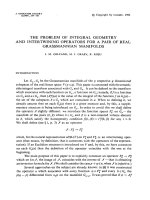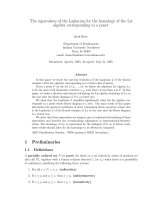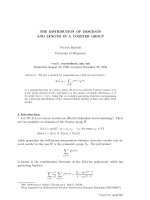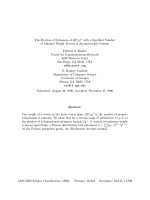Báo cáo toán học: "Depth reduction of a class of Witten zeta functions" pdf
Bạn đang xem bản rút gọn của tài liệu. Xem và tải ngay bản đầy đủ của tài liệu tại đây (97.41 KB, 7 trang )
Depth reduction of a class of Witten zeta functions
Xia Zhou
∗
Department of mathematics
Zhejiang University
Hangzhou, 310027
P.R.China
David M. Bradley
Department of Mathematics & Statistics
University of Maine
5752 Neville Hall Orono, Maine 04469-5752
U.S.A
,
Tianxin Cai
Department of mathematics
Zhejiang University
Hangzhou, 310027
P.R.China
Submitted: Apr 6, 2008; Accepted: Jul 21, 2009; Pub lish ed : Jul 31, 2009
Mathematics Subject Classifications: 11A07, 11A63
Abstract
We show that if a, b, c, d, f are positive integers such that a +b+c+ d +f is even,
then the Witten zeta value ζ
sl(4)
(a, b, c, d, 0, f ) is expressible in terms of Witten zeta
functions with fewer arguments.
1 Introduction
Let N be the set of positive integers, Q the field of rational numbers, C the field of
complex numbers.
For any semisimple Lie algebra g, the Witten zeta function(cf. [5]) is defined by
ζ
g
(s) =
ρ
(dim ρ)
−s
,
where s ∈ C and ρ runs over all finite dimensional irreducible representations of g. In
order the calculate the volumes of certain moduli space, Witten [7] introduced the values
∗
The first and third authors are supported by the National Natura l Science Foundation of China,
Project 10871169.
the electronic journal of combinatorics 16 (2009), #N27 1
ζ
g
(2k) for k ∈ N and showed that π
−2k l
ζ
g
(2k) ∈ Q, where l is the number of positive
roots of g.
For positive integer r, Matsumoto and Tsumura [5] defined a multi-variate extension,
called the Witten multiple zeta-function associated with sl(r + 1), by
ζ
sl(r+1)
(s) =
∞
m
1
, ,m
r
=1
r
j=1
r−j+1
k=1
j+k−1
v=k
m
v
−s
j,k
(1)
where
s = (s
j,k
)
1≤j≤r; 1≤k≤r−j+1
∈ C
r(r+1)/2
, ℜ(s
j,k
) > 1.
In particular ( [5 ], section 2, Prop 2.1), if m ∈ N we denote
ζ
sl(r+1)
(2m) :=
1≤j<k≤r+1
(k − j)ζ
sl(r+1)
( 2m, . . . , 2m
r(r+1)/2
).
As in [1], given the Witten multiple zeta-function (1), we define the depth to be r. Further,
if the zeta functions y
1
, . . . , y
k
have depth r
1
, . . . , r
k
respectively, then for a
1
, . . . , a
k
∈ C,
we define the depth o f a
1
y
1
+ · · · + a
k
y
k
to be max{r
i
: 1 ≤ i ≤ k}. We would like to
know which sums can be expressed in terms of lower depth sums. When a sum can be so
expressed, we say it is reducible.
An explicit evaluation for ζ
sl(3)
(2m) (m ∈ N) was independently discovered by D. Za-
gier, S. Garoufalidis, and L. Weinstein (see [8, page 506]). In [3], Gunnells and Sczech
provided a generalization of the continued-fraction algorithm to compute high-dimensional
Dedekind sums. As examples, t hey gave explicit evaluations of ζ
sl(3)
(2m) and ζ
sl(4)
(2m).
Matsumoto and Tsumura [5] considered functional relations for Witten multiple zeta-
functions, and found that
(−1)
a
ζ
sl(4)
(s
1
, s
2
, a, s
3
, 0, b) + (−1)
b
ζ
sl(4)
(s
1
, s
2
, b, s
3
, 0, a)
+ ζ
sl(4)
(a, 0, s
2
, s
1
, b, s
3
) + ζ
sl(4)
(b, 0, s
1
, s
2
, a, s
3
) (2)
is reducible for any a, b ∈ N and s
1
, s
2
, s
3
∈ C.
In this paper, we provide a combinatorial method which gives a simpler formula for
the quantity (2). Furthermore, we show that if a, b, c, d, f are positive integers such that
a + b + c + d + f is even, then ζ
sl(4)
(a, b, c, d, 0 , f ) is reducible.
2 Functional relation
Lemma 2.1. If the function F : Z
≥0
× Z
≥0
× C → C has the property that there exist
p, q ∈ C such that for every a, b ∈ N and every s ∈ C the relation
F (a, b, s) = pF (a − 1, b, s + 1) + qF (a, b − 1, s + 1)
the electronic journal of combinatorics 16 (2009), #N27 2
holds, then for every a, b ∈ N and every s ∈ C,
F (a, b, s) =
b
j=1
p
a
q
b−j
a + b − j − 1
a − 1
F (0, j, a + b + s − j)
+
a
j=1
p
a−j
q
b
a + b − j − 1
b − 1
F (j, 0, a + b + s − j). (3)
Proof. It’s easy to prove Lemma 2.1 by induction.
The Euler sum of depth r and weight w is a multiple series of the form
ζ(s
1
, . . . , s
r
) :=
n
1
>···>n
r
>0
r
j=1
n
−s
j
j
, (4)
with weight w := s
1
+· · ·+s
r
. Now let’s recall the following result concerning the reduction
on the triple Euler sums.
Lemma 2.2 (Borwein-Girgensohn [2]). Let a, b, c be positive integers. If a + b + c is even
or less than or equal to 10, then ζ(a, b, c) can be expressed as a rational linear combination
of products of single and double Euler sums of weight a + b + c.
Lemma 2.3 (Huard-Williams-Zhang [4]). If a, b, c be positive integers, then
ζ
sl(3)
(a, b, c) =
a
j=1
a + b − j − 1
b − 1
+
b
j=1
a + b − j − 1
a − 1
ζ(a + b + c − j, j). (5)
Moreover, ζ
sl(3)
(a, b, c) can be explicitly evaluated in terms of the values of Riemann zeta
functions when a + b + c is odd.
Theorem 2.1. If a, b ∈ N, then
(−1)
a
ζ
sl(4)
(s
1
, s
2
, a, s
3
, 0, b) + (−1)
b
ζ
sl(4)
(s
1
, s
2
, b, s
3
, 0, a)
+ ζ
sl(4)
(a, 0, s
2
, s
1
, b, s
3
) + ζ
sl(4)
(b, 0, s
1
, s
2
, a, s
3
)
=
max(a,b)
i=1
a + b − i − 1
a − 1
+
a + b − i − 1
b − 1
(−1)
i
ζ(i)
× ζ
sl(3)
(s
1
, s
2
, s
3
+ a + b − i)
+
a
i=1
a + b − i − 1
b − 1
ζ(i)ζ
sl(3)
(s
1
, s
2
, s
3
+ a + b − i)
− ζ
sl(3)
(s
1
+ i, s
2
, s
3
+ a + b − i) − ζ
sl(3)
(s
1
, s
2
, s
3
+ a + b)
the electronic journal of combinatorics 16 (2009), #N27 3
+
b
i=1
a + b − i − 1
a − 1
ζ(i)ζ
sl(3)
(s
1
, s
2
, s
3
+ a + b − i)
− ζ
sl(3)
(s
2
+ i, s
1
, s
3
+ a + b − i) − ζ
sl(3)
(s
1
, s
2
, s
3
+ a + b)
. (6)
Proof. From the definition (1) of the Witten multiple zeta-function, we have
ζ
sl(4)
(s
1
, s
2
, s
3
, s
4
, s
5
, s
6
) = ζ
sl(4)
(s
3
, s
2
, s
1
, s
5
, s
4
, s
6
). (7)
Next, for any a, b ∈ N and s
1
, s
2
, s
3
∈ C, since
ζ
sl(4)
(s
1
, s
2
, a, s
3
, 0, b) = ζ
sl(4)
(s
1
, s
2
, a, s
3
+ 1, 0, b − 1) − ζ
sl(4)
(s
1
, s
2
, a − 1, s
3
+ 1, 0, b),
by Lemma 2.1, we have
ζ
sl(4)
(s
1
, s
2
, a, s
3
, 0, b) =
a
i=1
a + b − i − 1
b − 1
(−1)
a+i
ζ
sl(4)
(s
1
, s
2
, i, s
3
+ a + b − i, 0 , 0)
+
b
i=1
a + b − i − 1
a − 1
(−1)
a
ζ
sl(4)
(s
1
, s
2
, 0, s
3
+ a + b − i, 0, i). (8)
Similarly, we have
ζ
sl(4)
(s
1
, s
2
, b, s
3
, 0, a) =
b
i=1
a + b − i − 1
a − 1
(−1)
b+i
ζ
sl(4)
(s
1
, s
2
, i, s
3
+ a + b − i, 0, 0 )
+
a
i=1
a + b − i − 1
b − 1
(−1)
b
ζ
sl(4)
(s
1
, s
2
, 0, s
3
+ a + b − i, 0 , i), (9)
ζ
sl(4)
(a, 0, s
2
, s
1
, b, s
3
) =
a
i=1
a + b − i − 1
b − 1
ζ
sl(4)
(i, 0, s
2
, s
1
, 0, s
3
+ a + b − i)
+
b
i=1
a + b − i − 1
a − 1
ζ
sl(4)
(0, 0, s
2
, s
1
, i, s
3
+ a + b − i), (10)
and
ζ
sl(4)
(b, 0, s
1
, s
2
, a, s
3
) =
b
i=1
a + b − i − 1
a − 1
ζ
sl(4)
(i, 0, s
1
, s
2
, 0, s
3
+ a + b − i)
+
a
i=1
a + b − i − 1
b − 1
ζ
sl(4)
(0, 0, s
1
, s
2
, i, s
3
+ a + b − i). (11)
the electronic journal of combinatorics 16 (2009), #N27 4
Since
ζ
sl(4)
(a, b, c, d, 0 , 0) = ζ(c)ζ
sl(3)
(a, b, d), (12)
ζ
sl(4)
(a, b, 0, c, 0, d) =
n
1
,n
2
=1
v>n
1
+n
2
1
v
d
n
a
1
n
b
2
(n
1
+ n
2
)
c
=
n
1
,n
2
=1
v>n
1
+n
2
1
v
d
n
b
1
n
a
2
(n
1
+ n
2
)
c
, (13)
ζ
sl(4)
(a, 0, b, c, 0, d) =
n
1
,n
2
=1
v<n
1
1
v
a
n
c
1
n
b
2
(n
1
+ n
2
)
d
, (14)
ζ
sl(4)
(0, 0, a, b, c, d) =
n
1
,n
2
=1
n
1
+n
2
>v>n
1
1
v
c
n
a
1
n
b
2
(n
1
+ n
2
)
d
, (15)
we find that
ζ
sl(4)
(s
1
, s
2
, 0, s
3
+ a + b − i, 0 , i) + ζ
sl(4)
(i, 0, s
2
, s
1
, 0, s
3
+ a + b − i)
+ ζ
sl(4)
(0, 0, s
1
, s
2
, i, s
3
+ a + b − i)
= ζ(i)ζ
sl(3)
(s
1
, s
2
, s
3
+ a + b − i) − ζ
sl(3)
(s
1
+ i, s
2
, s
3
+ a + b − i)
− ζ
sl(3)
(s
1
, s
2
, s
3
+ a + b) (16)
and
ζ
sl(4)
(s
1
, s
2
, 0, s
3
+ a + b − i, 0 , i) + ζ
sl(4)
(i, 0, s
1
, s
2
, 0, s
3
+ a + b − i)
+ ζ
sl(4)
(0, 0, s
2
, s
1
, i, s
3
+ a + b − i)
= ζ(i)ζ
sl(3)
(s
1
, s
2
, s
3
+ a + b − i) − ζ
sl(3)
(s
2
+ i, s
1
, s
3
+ a + b − i)
− ζ
sl(3)
(s
1
, s
2
, s
3
+ a + b) (17)
Now combining equations (8-17), we complete the proof.
Lemma 2.4. Every Witten multiple zeta value of the form ζ
sl(4)
(a, b, 1, d, 0, 1) with a, b, d ∈
N can be expressed as a rational linear combination of products of single and double Euler
sums when a + b + d is even or a + b + d ≤ 8.
Proof.
ζ
sl(4)
(a, b, 1, d, 0, 1) =
a
i=1
a + b − i − 1
b − 1
ζ
sl(4)
(i, 0, 1, a + b + d − i, 0, 1)
+
b
i=1
a + b − i − 1
a − 1
ζ
sl(4)
(0, i, 1, a + b + d − i, 0, 1). (18)
the electronic journal of combinatorics 16 (2009), #N27 5
However, for any a, d ∈ N,
ζ
sl(4)
(a, 0, 1, d, 0, 1) = ζ
sl(4)
(0, a, 1, d, 0, 1)
= ζ
sl(4)
(a, 0, 1, 0, 0, d + 1) +
d
i=1
ζ(d + 2 − i, i, a), (19)
and
ζ
sl(4)
(a, 0, 1, 0, 0, d + 1) = ζ(d + 1, a, 1) +
a
i=1
ζ(d + 1, a + 1 − i, i). (20)
We complete the proof by combining this with Lemma 2.2.
Theorem 2.2. Every Witten multiple zeta value of the form ζ
sl(4)
(a, b, c, d, 0 , f ) with
a, b, c, d, f, ∈ N can be expressed as a rational linear combination of products of single and
double Euler sums when a + b + c + d + f is even or a + b + c + d + f ≤ 10.
Proof. From Lemma 2.1, we see that
1
n
a
1
n
b
2
n
c
3
(n
1
+ n
2
)
d
(n
1
+ n
2
+ n
3
)
f
=
c
i=1
c + f − i − 1
f − 1
(−1)
c+i
1
n
a
1
n
b
2
n
i
3
(n
1
+ n
2
)
c+d+f−i
+
f
i=1
c + f − i − 1
c − 1
(−1)
c
1
n
a
1
n
b
2
(n
1
+ n
2
)
c+d+f−i
(n
1
+ n
2
+ n
3
)
i
. (21)
Also
1
n
a
1
n
b
2
(n
1
+ n
2
)
c+d+f−i
(n
1
+ n
2
+ n
3
)
i
=
a
j=1
a + b − j − 1
b − 1
1
n
j
1
(n
1
+ n
2
)
a+b+c+d+f−i−j
(n
1
+ n
2
+ n
3
)
i
+
b
j=1
a + b − j − 1
a − 1
1
n
j
2
(n
1
+ n
2
)
a+b+c+d+f−i−j
(n
1
+ n
2
+ n
3
)
i
. (22)
Now combine (20), (21) and Lemma 2.4 and sum over all ordered triples of positive integers
(n
1
, n
2
, n
3
) to obtain
ζ
sl(4)
(a, b, c, d, 0 , f ) =
c
i=2
c + f − i − 1
f − 1
(−1)
c+i
ζ(i)ζ
sl(3)
(a, b, c + d + f − i)
the electronic journal of combinatorics 16 (2009), #N27 6
+
f
i=2
c + f − i − 1
c − 1
(−1)
c
a
j=1
a + b + j − 1
b − 1
× ζ(i, c + d + f + a + b − i − j, j)
+
b
j=1
a + b + j − 1
a − 1
ζ(i, c + d + f + a + b − i − j, j)
− (−1)
c
c + f − 2
c − 1
ζ
sl(4)
(a, b, 1, c + d + f − 2, 0, 1). (23)
By Lemmas 2.2, 2.3 and 2.4, we complete the proof.
Remark. When d = 0, t he Witten zeta value ζ
sl(4)
(a, b, c, 0, 0, f ) can also be viewed as a
Mordell-Tornheim sum with depth 3. The fact that every such sum can be expressed as a
rational linear combination of products of single and double Euler sums when the weight
a + b + c + f is even has been shown in [6] and [9].
Acknowledgment. The authors are gra t eful to the referee for carefully r eading the
manuscript and providing several constructive suggestions.
References
[1] J. M. Browein, D. M. Bradley, D. J. Broadhurst and P. Lisonek, Special values of
multiple polylogarithms, Trans. Amer. Math. Soc. 353 (2001), no. 3 p. 907-941.
[2] J. M. Borwein and R. Girgensohn, Evaluations of triple Euler sums, Electron. J. Com-
bin., 3 (1996) , no. 1, Research Paper 23, approx. 27 pp.
[3] P. E. Gunnells and R. Sczech, Evaluations of Dedekind sums, Eisenstein cocycles,
and special values of L-functions, Duke. J. Math., 118 (2003), p. 229-260.
[4] J. G. Huard, K. S. Williams and N. Y. Zhang, On Tornheim’s double series, Acta
Arith., 75 (1996), no 2, 105 –117. [MR 1379394] (97f:11073)
[5] K. Matsumoto and H. Tsumura, On Witten multiple zeta-functions associated with
semisimple Lie Algebras I, Ann. Inst. Fourier, 56(5) (2006), p. 1457-1504 .
[6] H. Tsumura, On Mordell-Tornheim zeta values, Proc. Amer. Math. Soc., 133 (2005),
no. 8, 2387–2 393. [MR 2138881] (2006k:11179)
[7] E. Witten, On quantum gauge theories in two dimensions, Comm. Math. Phy. 141
(1991): 153-209.
[8] D. Zagier, Values of zeta functions and their applications, in Proc. First Congress of
Math.,Paris, vol. II Prog r ess in Math., vol. 120, Birkh¨auser, 1994, p. 497-512.
[9] X. Zhou, D. M. Bradley and T. Cai, On Mordell-Tornheim sums and multiple zeta
values, submitted.
the electronic journal of combinatorics 16 (2009), #N27 7









